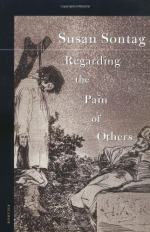
|
| Name: _________________________ | Period: ___________________ |
This test consists of 15 multiple choice questions and 5 short answer questions.
Multiple Choice Questions
1. According to Sontag, why do images of atrocities fail to convey a singular, universal message?
(a) They are inappropriate for mass publication.
(b) They inspire only disgust.
(c) They are too graphic.
(d) They require context and explanation.
2. Sontag claims that images of suffering in Africa send a double message. Which of the following best represents that message?
(a) Violence is abhorrent in any case; therefore, we must interfene to stop such atrocities.
(b) Suffering like this only happens in backward places like Africa; thus, America and other developed nations are clearly superior.
(c) The suffering depicted in the photographs was inhumane and should be prevented; however, it is to be expected of a place like Africa.
(d) Places like Africa always face horrors like this; therefore, intervention is a waste of resources.
3. Sontag discusses one year in European history in which the photograph was able to truly capture the nature of human atrocities. Which year was it?
(a) 1945.
(b) 1912.
(c) 1975.
(d) 1902.
4. Fenton received directions from the War Office to do which of the following?
(a) Avoid photographing the ill, wounded, dying and dead.
(b) Glorify war through patriotic images.
(c) Generate propaganda for Britain.
(d) Graphically depict the horrors of war.
5. Sontag argues that we are most disappointed to discover that which type of photographs have been staged?
(a) Images depicting everyday life.
(b) Images depicting gory battle scenes.
(c) Images depicting spontaneous events.
(d) Images depicting intimate climaxes.
6. Sontag lists which of the following as images that the artist "takes"?
(a) Paintings.
(b) Etchings.
(c) Photographs.
(d) Drawings.
7. Restrictions on media coverage of the British campaign in the Falklands was notable for which of the following reasons?
(a) They allowed only government-sponsored journalists.
(b) They prohibited foreign journalists from covering the story.
(c) They opened the event to full-scale television coverage.
(d) They were stricter than any censorship since the Crimean War.
8. Sontag notes that post-colonial Africa is most commonly known to the American public based on a series of which of the following groups of images?
(a) Images of post-war development and national improvement.
(b) Photographs of the famine fields of Biafra, the Rwandan genocide, and the AIDS epidemic.
(c) Still images of freedom fighters, revolutionary independence movements, and guerrilla insurgencies.
(d) Images of American aid groups, support-a-child network assistants, and refugee camps.
9. Sontag argues that Woolf's view, like many other "antiwar polemicists" is:
(a) Generic.
(b) Idealistic.
(c) Narrow-minded.
(d) Out-dated.
10. Sontag notes that images of war most significantly influenced which of the following groups?
(a) Artists whose work centers on conscientious objection.
(b) Those who had experienced war, and were suffering from post-traumatic stress.
(c) Those who had never experienced war first-hand.
(d) Governing officials making war decisions.
11. Sontag discusses the subtitle of "Here is New York" in some detail. What was this subtitle?
(a) "A City Mourns."
(b) "September 11th, 2001."
(c) "A Nation in Shock."
(d) "A Democracy of Images."
12. Goya's "Los Desastres de la Guerra" (The Disasters of War) was a series of etchings published in 1863. Which of the following events does this series depict?
(a) The bombing of Guernica.
(b) The Spanish Civil War.
(c) Napoleon's invasion of Spain.
(d) World War I.
13. Faced with "information overload," people remember a photograph because it is a quick way of storing information, much like which of the following strategies?
(a) Quotations, mnenics and memory games.
(b) Maxims, proverbs and songs.
(c) Quotations, maxims and proverbs.
(d) Jingles, mnemonics and rhymes.
14. At the end of World War II, a group of journalists formed Magnum Photo Agency. Which of the following photographers was not among them?
(a) David Seymour.
(b) Robert Capa.
(c) Henri Cartier-Bresson.
(d) Ernst Friedrich.
15. Which was the first war to be covered by television cameras?
(a) The Korean War.
(b) The Vietnam War.
(c) Desert Storm.
(d) The War on Terror.
Short Answer Questions
1. After World War I, the general public thought of the War as:
2. Who took the infamous image of Brigadier General Nguyen Ngoc Loan executing a Vietcong suspect in the street?
3. Which technological advancement changed the way war was photographed after World War I?
4. Sontag claims that "good taste" is always _________ when invoked by institutions.
5. The first war photographer, whose work garnered him the position as "official photographer" of the Crimean War, was which of the following?
|
This section contains 727 words (approx. 3 pages at 300 words per page) |

|




